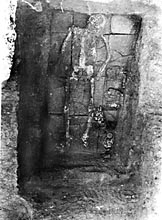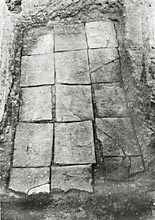


|
The simplest type of grave was the 'pit-grave'. This was a pit dug into the ground. Its walls were sometimes plastered with lime, and its earth floor was covered with a layer of pebbles or stones. From archaeological finds we know that the tomb was sealed by slabs. Any grave-offerings were placed either inside the tomb or next to it, and there was normally one grave per person. Multiple burials in pit-graves are occasionally found in Classical Athens, but they were due to unusual circumstances, such as the plague epidemic during the Peloponnesian war (Thucydides 3.87). |
 |
 |

Built tombs were either free-standing buildings or annexes (on one or more sides) to other structures. Built to house a grave, they were either made entirely of brick or had brick side-walls and an ashlar frontage of stone. Often they were capped with low cornices (some of which still bear traces of decoration). Inside and outside a built tomb, there were gutters running the whole length of its wall, for offerings to be poured into. A gravestone was often placed on a built tomb.


'Cenotaphs' were empty tombs for those who had died in a far away country, or whose bones could not be found (as for example in the case of death at sea). Cenotaphs were a part of the complex of public graves found along the road to the Academy; and they were also used for private burials. Offerings were also made at cenotaphs: in some cases, they were placed around a large rock simulating the corpse.
Tomb clusters in Classical Athens were often surrounded either by a circular mound or by a four-sided cemetery circuit wall.
 |
 |
|
| |
|||
| |||